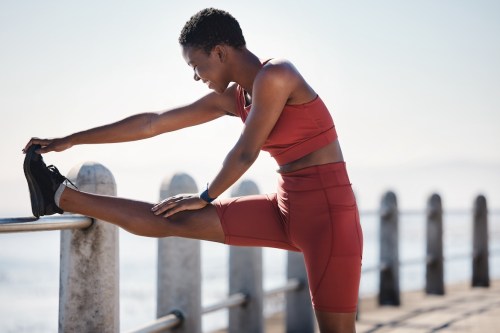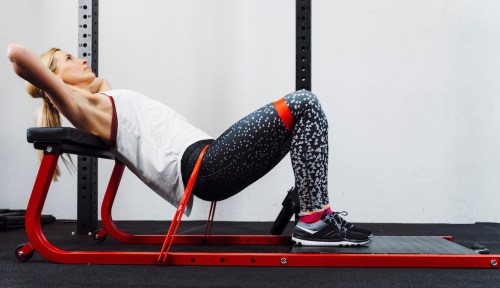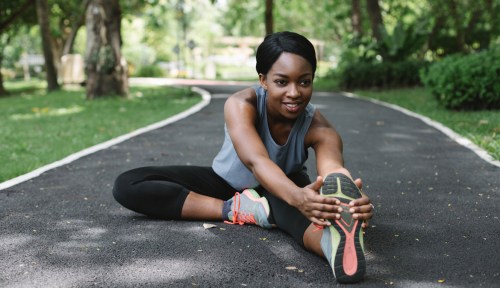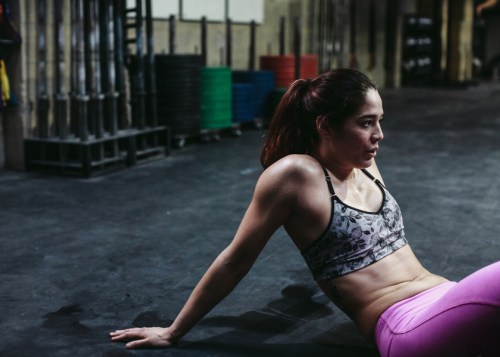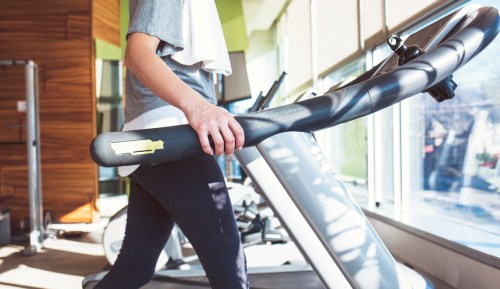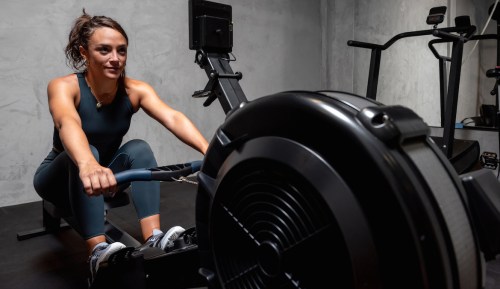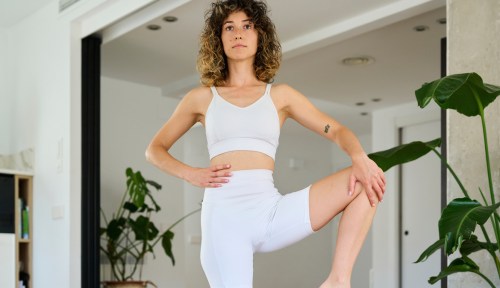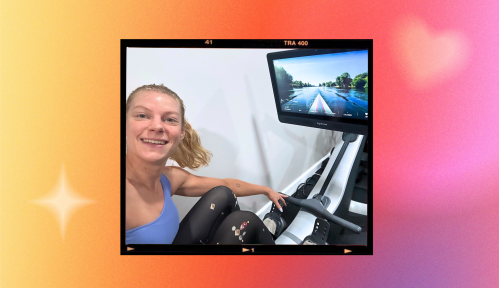Our editors independently select these products. Making a purchase through our links may earn Well+Good a commission
There are a couple of things I love about being done with a workout. Number one is that I’m riding high on endorphins. And two is that I get to feel that uber-satisfying accomplishment of having sore muscles after a workout.
Experts in This Article
certified personal trainer and creator of BodyFit by Amy
strength and conditioning coach and former senior performance scientist at WHOOP
celebrity trainer
New York City-based exercise physiologist
So when I work my butt off and don’t experience that familiar feeling, I can’t help but wonder: Why am I not sore after a workout?
But first, why do we often get sore after working out?
According to Cedric Unholz, strength and conditioning coach and former senior performance scientist at WHOOP, post-workout soreness is scientifically known as delayed-onset muscle soreness (DOMS).
“This soreness is typically caused by exercise involving eccentric loading and/or unfamiliar movements that the body is unaccustomed to at the time of the training session,” he explains. “Symptoms include stiffness, decreased joint range of motion, reduced force/power production capacity, and inflammation.”
Sometimes soreness isn’t from your workout at all, but how your body was prepped—or, not prepared—properly beforehand.
“Soreness can also mean that you didn’t hydrate, you didn’t properly fuel yourself, or your body may be tired, which means it’s exerting itself even more,” says celebrity trainer Chase Weber.
Rondel King, MS, an exercise physiologist in New York City, adds that post-workout soreness essentially means that you’ve damaged your muscle fibers (which is necessary for building greater strength and bigger muscles).
While all of those things (save for the muscle gains) sound less than pleasant, I’d be lying if I said those side effects don’t sometimes feel like the goal. I mean, yeah it sucks when going up stairs hurts and my legs feel really heavy—but it also makes me feel proud, because I know that I’ve put in some good work during my sweat sesh. It’s also exactly why I get kind of mad if my muscles aren’t sore after a workout.
I’m not alone, either—being sore has become fitness currency of sorts. It’s definitely misleading, though.
“If you’re a high-level athlete or a seasoned gym-goer, you’re trying all sorts of things to feel soreness because it gives you that feeling that you’re accomplished,” King says. “But it gets to a point where it’s not necessary to feel that soreness.”
Is not feeling sore after a workout bad?
Believe it or not, not feeling sore after a workout could actually mean that you’re in better shape than you might think—it’s a fitness recovery indicator.
“Working out is providing a stimulus to muscles and actually changes them structurally,” King explains.
With that in mind, he says that not feeling sore after a workout can actually be a good indicator—it could mean your body is adapting to the stress and strain of lifting and moving.
Which is all to say, just because you aren’t sore after a workout doesn’t mean that your workout was worthless. Rather, when you no longer feel sore performing certain exercises, it can be a sign that you’ve leveled up your fitness, and are ready to progress to even more challenging workouts.
“Soreness can also mean that you didn’t hydrate, you didn’t properly fuel yourself, or your body may be tired, which means it’s exerting itself even more.” —Chase Weber, celebrity trainer
How to tell if your strength training is effective
Because muscle soreness is an indicator of workout effectiveness for so many (however misguided it may be), there’s the common misconception that not being sore equates to an ineffective workout. That’s not necessarily the case, though. According to personal trainer Amy Schemper, CPT, it’s more accurate to analyze how you feel during your workout.
“This can be a better indicator of how you’re challenging your muscles,” she says. “As you get stronger: Are you lifting enough that your muscles start to fatigue during the last few repetitions of a set? Do exercises feel too easy, or like you could continue on for more reps than prescribed? At the end of a workout, do you feel like you’ve worked hard? Listening to your body is one of the best ways to know if you’re strength training effectively.”
What level of soreness is indicative of a good workout?
If you’re regularly working your muscles, eventually they become accustomed to the movements, so soreness may become less common.
Because of this, there’s no “right” level of soreness after a workout, Schemper says. “Nor is there a type of pain you should aim for when it comes to working out,” she adds. “If you are trying something new, or increasing variables in your existing workout (weight, volume, time under tension), you can generally expect more muscle soreness to occur.”
In that sense, if you’re not sore, you can take it as a sign to switch up your regimen—but only do so if you feel fully able to execute full reps and sets of your new chosen resistance or weight. What you want to strive for is muscle fatigue and recovery.
So, why am I not sore after a workout?
Understanding the effects of your workout is imperative for getting the most out of your movement. Here are some reasons why you might not experience that satisfying post-workout soreness.
1. Your body has adapted—and it’s time to switch it up
One good reason why you may not be sore after working out is that your fitness game is improving.
“It may be saying that you’re getting in better shape,” Weber says. “You may be ready to move up in your weights, take it to the next step, and move things up a notch. You are probably accomplishing some goals and not in as bad of shape as you think you are.”
Consider whether it’s time for heavier weights or more reps in order to keep challenging your body.
2. You didn’t push yourself hard
Sore or not, it all comes down to what you’re putting into your workout.
“If you pushed yourself, that’s what matters,” Weber says.
That said, how hard you work really depends on your goals, Unholz says. You don’t always want to push so hard that you end up sore, he points out. For example, before a big race or competition, it’s smarter not to overdo it.
“In [that] case, movement intent is very high, but the movements and loads used should cause no significant soreness based on the purpose of that session,” he says.
3. You’re skipping out on eccentric exercises
Not all exercises are created equally and, as such, they don’t all lead to the same type of (if any) soreness.
Generally speaking, Unholz says that eccentric exercises—when the muscle is lengthening under load, like when you’re coming out of a biceps curl—are responsible for causing soreness, as they’re the main drivers for inducing muscle damage.
So, if you’re not sore post-sweat, he says that the workout likely didn’t provide a substantial amount of eccentric stress.
“Listening to your body is one of the best ways to know if you’re strength training effectively.” —Amy Schemper, CPT
How to treat and prevent delayed onset muscle soreness
While soreness can mean that you’re working in the right direction, there’s no denying that it’s not always convenient and it’s rarely comfortable. Thankfully, there are ways to treat and prevent muscle soreness.
According to Unholz, the best ways to do so are as follows:
- Use an appropriate weight when lifting—it should be challenging but not impossible
- Space out eccentric workouts to give your body more time to recover
- Get plenty of sleep
- Incorporate active recovery into your routine
- Consider thermal therapy (hot and cold modalities can work wonders for recovery)
Another option? Add a dynamic mobility workout to your routine, Schemper says.
“Stretching or foam rolling after a workout can make you feel better,” she says. Booking a massage—or giving yourself one with a percussive device, like a Theragun Mini ($169)—can also help. (You can even follow it up with a cooling muscle rub or CBD muscle relaxer for further relief.) “Listen to your body, and remember it’s all part of the process!”
FAQ
If I’m not sore, am I still building muscle?
You sure are! According to Unholz, muscle gains are determined by three factors: mechanical tension, muscle damage, and metabolic stress.
“From a programming perspective, these three factors must be applied in conjunction with the foundational training principles of specificity, progressive overload, recovery planning, and appropriate periodization principles for optimal muscle growth outcomes,” he says. “It is possible to build muscle without resulting soreness as muscle damage is only one of the key driving factors that correlates with hypertrophy.”
That said, if you’re never feeling any muscle soreness, your workout program might not be ideal.
“When looking to build muscle, engaging in training that does not result in some degree of muscle soreness periodically is likely to produce suboptimal results,” Unholz says.
Can I work out every day if I’m not sore?
It depends on the workout. Most times, trainers recommend working out three to five days per week with active recovery days in between.
“It is definitely possible to work out every day if you are not sore depending on what training is being performed—for example, alternating between resistance training and aerobic training days,” Unholz says.
Is it bad to stay sore for days after a workout?
It really depends on the individual. Where dedicated gym rats may rarely feel sore, workout newbies likely will experience soreness for longer than just a day or so.
“Soreness just means you worked a muscle that hasn’t been worked in a while, or that the muscle didn’t have enough endurance,” Weber says, noting that it’s not typically something to be concerned about. “It could also be sore or more tender than normal because it was a different movement.”
That said, Schemper points out that post-workout soreness typically only lasts a few days, up to a week.
“Anything longer than that could be a sign of a potential injury,” she says. “If you’re experiencing pain in a tendon or a joint, or sharp pains instead of aching muscles, it could be time to consult your healthcare provider.”
Can I still work out if I’m feeling sore?
Absolutely! Just be sure to tune into your body to determine the type of soreness you’re feeling. If it feels debilitating, consider skipping a day or don’t go all out.
“While it’s tempting to stay on the couch and do nothing when you’re feeling sore, getting active can actually help relieve some soreness, as you increase blood flow,” Schemper says. “Aim for a lower-intensity, active recovery type of workout, such as walking, mobility, yoga, or Pilates.”
Try these stretches for sore muscles to find some relief:
Sign Up for Our Daily Newsletter
Get all the latest in wellness, trends, food, fitness, beauty, and more delivered right to your inbox.
Got it, you've been added to our email list.
